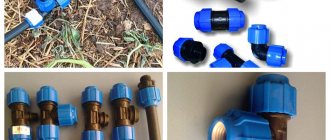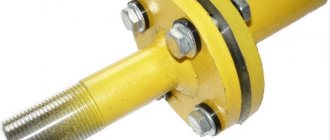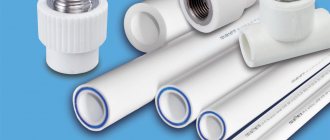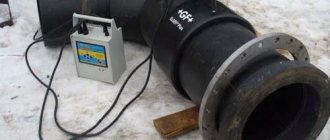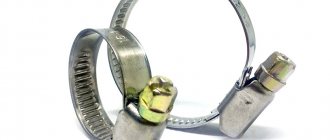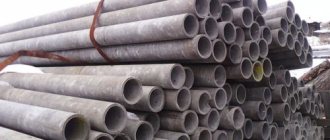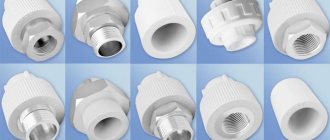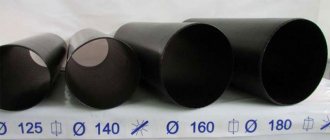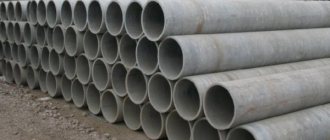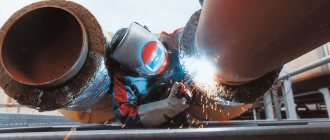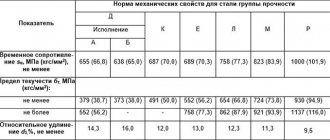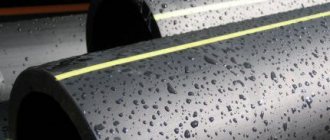This material may be useful for those residents who are replacing plumbing fixtures in their own home. Currently, pipes made of polymer materials are most often used for laying water supply and sewerage systems. In this article I will present several methods of joining polyethylene pipes using various types of couplings.
Coupled corner connection of a sewer pipe.
What is PP coupling
A coupling is a connecting part for installing various types of pipes into a single pipeline. This is a universal type of fitting that is suitable for all types of pipe products.
The item became widespread due to its versatility and low cost. Installation does not take much time, and the work is not particularly difficult, so even a non-professional can handle it.
Products made from polypropylene have a number of undeniable advantages:
- Light weight.
- The melting point is 160–170 °C, which makes it possible to use them for working with hot water.
- The product is highly durable: it will take considerable effort to damage the coupling.
- With proper use, the service life is about 50 years.
- The material is soundproofing, so the sound of liquid movement will not be heard.
- Does not conduct electric current.
- It is highly resistant to active chemicals.
- The material is harmless to people and the environment under normal operating conditions, but it is worth considering that during combustion toxic substances are released in large volumes.
- Not subject to corrosion.
Disadvantages include:
- The vulnerability threshold of the material starts from -10 °C. At low temperatures, elasticity is lost, the walls of the pipe become brittle and unstable to mechanical damage, and accordingly, it is not suitable for outdoor use.
- The material is highly flammable and not resistant to open fire and high temperatures, so you should not place polypropylene products, for example, next to the stove.
- Polypropylene is a material that also does not withstand high temperatures.
We recommend that you read: Which gas torch to choose for soldering copper pipes - a review of the best
Note! It is not recommended to use polypropylene in systems with temperatures above 95 °C. Under high temperature exposure, polypropylene loses strength and becomes less resistant to any mechanical damage. In addition, leaks may occur at pipe joints.
Technical characteristics of the coupling for polypropylene pipes
Couplings for welding polypropylene pipes are made of the same material as the pipes themselves. That is, made of polypropylene. Therefore, both products have the same technical characteristics.
Basic:
- Density – 0.9 g/cm³.
- Hardness – 40 N/mm².
- Tensile strength – 40 N/mm².
- Elastic modulus – 800 N/mm².
- Kinematic viscosity – 420-500 cm³/g.
- Thermal conductivity – 0.24 W/m C.
The fitting can withstand all loads to which the line may be subjected. Hence the advantages:
- high strength of the product;
- resistance to all active and aggressive environments, which makes it possible to avoid corrosive processes;
- the passage of the fittings is maintained due to the fact that their internal diameter does not decrease during operation due to salt and mud deposits;
- lack of electrical conductivity, which ensures safe operation of both couplings and polypropylene products;
- excellent sound insulation;
- low thermal conductivity, allowing to reduce heat losses of the line;
- withstands temperatures up to +95°C (short-term +110°C), which makes it possible to use fittings in heating and hot water supply systems;
- low specific gravity;
- ease of installation at the connecting joint of two polypropylene pipes;
- service life more than 50 years.
Polypropylene couplings are more expensive than many other connecting elements. But they are cheaper than their metal counterparts. Their quality is high due to the production technology used, which is based on polypropylene extrusion (when molten raw materials are fed into molds under high pressure). Hence not only the quality, but also the exact dimensions. All this makes it possible to use fittings in various engineering networks.
Scope of application of polypropylene couplings
Polypropylene couplings are used to connect:
- Plumbing pipes.
- Heating systems.
- Sewage systems.
- Technical pipeline.
The peculiarity of connections using a coupling is that, depending on the type, it can be used to connect to various types of pipes.
For example, combined ones are suitable for connecting PP pipes with metal ones, and threaded ones are even suitable for connecting two threaded metal pipes.
Where are couplings for polypropylene pipes used?
Polypropylene couplings can be used in the following engineering systems:
- water supply – cold, hot;
- heating – radiator, heated floors;
- conditioning;
- pipelines at industrial facilities through which various liquids move, including aggressive ones;
- melioration and irrigation networks;
- drainage.
Two different couplings in a heating system
Connecting pipes using PP couplings
Thanks to the variety of polypropylene pipes, you can create different joints. Various methods are used to ensure a reliable connection.
The highest level of tightness is achieved by welding, which allows you to assemble the most durable single structure. Welding does not require additional fasteners, and creates a one-piece pipeline, so if repairs are necessary to replace the coupling, cutting off a section of the pipe will be required.
Other types of connections, for example, a threaded connection, or a clamp with a union nut (another name is American) will also provide an acceptable level of tightness, while simplifying the maintenance and repair of the structure due to the ability to easily disassemble the connection.
Attention! Combining different types of couplings and types of paper clips allows you to create a pipeline of any complexity.
Couplings
They are used for installation of heating, water supply, sewerage systems for fastening pipes of identical size.
Installation is carried out using a one-piece welding method. They can also be used for reinforced polyethylene pipes that can withstand temperatures up to 95 °C and pressure levels up to 25 atmospheres, therefore they can easily withstand temperature conditions in domestic heating systems.
Transitional
A transition coupling is used to transition from one pipe diameter to another. Often used when connecting to a manifold or as an adapter to another section of the pipe. Suitable for all types of pipes.
We recommend that you read: Fittings for electric welded pipes
Combined with internal thread
Used when a clip is required with an existing classic pipeline, for example, metal. And also for connection with shut-off valves in the form of taps, meters, barometers.
A metal bushing with thread is pressed inside the PP coupling. The thread pitch on the coupling must exactly match the thread pitch on the target pipe.
The internal thread is suitable for working with open-end wrenches. For this purpose, special edges are made on the outer side of the thread.
Combined with external thread
Like the previous type, the main task of this coupling is to connect with other types of pipes or shut-off valves. The only difference is that the thread is external. You can screw another coupling or tap onto the thread. As in the previous case, there are couplings with open-end wrench faces.
Note! PP couplings are not only a reliable method of connecting pipes made of this material, but are also suitable for connecting other types of pipelines.
Classification by connection type
Depending on the type of connection, there are detachable and permanent couplings.
- Detachable . Characteristic for threaded connections. Easy to install, provide acceptable tightness and ease of maintenance. In the event of a leak in a connection using detachable fittings, replacing the element is much easier than in the case of a permanent connection, when you have to cut off a section of the pipe. This type includes combined PP fittings that are not intended for welding. For example, threaded, or with a union nut (“American”).
- One-piece . This type of connection includes the welding method. Provides an extremely high level of tightness. Connecting, transitional PP couplings are usually designed specifically for the permanent connection method. One-piece fittings also include combined fittings with a welded part.
How to connect plastic pipes
First of all, when installing or replacing plastic pipes, it is necessary to understand what the scope of use will be, since it is necessary to connect plastic pipes for water supply under different conditions from assembling structures for heating or sewerage.
Let's try to understand the features for each area of future use:
- water pipes - here, first of all, you need to decide whether the design will be internal or external. It is also important to immediately understand the temperature indicators of passing liquids (for plastic pipes, the maximum water temperature does not exceed 100 degrees, and the pressure often does not exceed 5 atmospheres). Metal-plastic products are recommended for constructing water supply networks;
- heating structures - when creating these systems, it is also worth considering the location of the products and the maximum temperature of the liquids. Before the advent of metal-plastic products, which entered the market relatively recently - about 10 years ago, polyethylene, polyvinyl chloride and polymer fittings were often used to create heating systems. However, the owners began to note that under the influence of temperatures, the structures began to deform, which spoiled the aesthetics (if located externally) or the wall itself (if located in the wall);
- sewer systems - structures made of polyethylene, PVC and polypropylene are mainly used. Here, when choosing, you should give preference to products with a long service life, not forgetting about compliance with connection technologies to make this service life really long.
PVC pipe connection
The connection of polyvinyl chloride pipes is carried out either by a master or with your own hands, since connecting PVC pipes will not be difficult at all, even if you have no experience.
There are several types of PVC pipe connections:
- into the socket - to carry out this type of connection, it will be necessary to initially clean both ends of the plastic pipes from dirt and dust, and at the smooth end of the product, which will be inserted into the socket, it is even necessary to remove the chamfer. Next, it is checked that the elastic band in the connectors for PVC pipes is located evenly over the surface of the ring. It is recommended to treat the surfaces of the future connection with a special lubricant (the use of petrochemical oils is prohibited), after which the parts are directly connected, with the fittings located at the same level. If the connection is made correctly, then when checking, there will be the same distance to the rubber gasket around the circumference of the fitting (this is checked using a thin stick, which is placed between the surfaces of a smooth plastic pipe and the socket). The advantage of this method is that it is carried out without welding and without a soldering iron;
- flange method - this method is carried out using special cast iron flanges, which are placed on cut fittings using a rubber gasket. After the flange is completely placed on the end of the product and there is a rubber layer from the coupling between them, the craftsmen secure the cast iron connection using special bolts. This connection material has a longer service life, so this method is often used for water supply structures.
How to connect polypropylene pipes
To connect polypropylene products you will need a special soldering iron or welding machine.
Stages of connecting polypropylene parts:
- Marking and cutting the product into the necessary components.
- Cleaning surfaces from nicks and irregularities, treating with a degreaser.
- The depth of insertion of the plastic pipe into the fitting is noted; adapters for this are usually measured and left 1 mm to the outer wall.
- The end of the fitting and the fitting are heated on the soldering iron sleeve, and both parts are heated simultaneously, since if the technology is not followed, an inappropriate seam will be made, and the parts will be immediately rejected.
- After the required time has passed, both parts are removed and inserted into each other, without scrolling the elements.
Connection of polypropylene pipes.
Important! When soldering, the craftsman has a few seconds before the materials completely harden, which can allow him to adjust the location of the parts; otherwise, the resulting structure will have to be rejected.
Features of installation of metal-plastic pipes
When installing water supply systems, preference is increasingly being given to metal-plastic pipelines; this is due, among other things, to the ease of installation of such structures.
The connection of metal-plastic products is carried out using two types of fittings:
- Compression fittings - These consist of a direct threaded connector body, a ferrule, a union nut and an O-ring. This entire design allows you to connect metal-plastic products into a reliable water supply system. This installation method has enough advantages, ranging from the lack of specialized equipment (you only need a wrench of the appropriate size) to the possibility of replacing parts. The installation itself proceeds as follows: first, the screwing element and the crimp ring are removed, which are placed directly on the reinforcement. Next, the pipe is inserted into the threaded fitting until it stops, the ring is also tensioned to the end mark, and the final step is tightening the nut.
- Press fittings are an even simpler way to connect plastic pipes, however, you will need a special device for connecting parts - clamping pliers. The crimp sleeve is placed on the product, which is inserted all the way into the fitting body, then the sleeve is crimped using a tool. This design even allows you to rotate the fittings in the fitting without breaking the seal.
How to install polyethylene pipes
There are two types of installation of polyethylene products:
- Collapsible - connections that can be adjusted and repaired later are created using an appropriate fitting (steel flanges or compression fittings). With this connection method, you only need a wrench and a chamfer tool. Plastic pipes are processed, degreased and pre-lubricated to improve fit into the connecting elements. After this, the fitting is tightened with a wrench.
- Non-separable - do not require further disassembly; they are produced using welding. This method is often used to connect water supply networks due to their better tightness and resistance to pressure changes. Here the master will need a welding machine. When carrying out installation, it is worth remembering that the melting point of HDPE products is 270 degrees.
Important! It is recommended to weld polyethylene reinforcements at an ambient temperature of at least +5°C, and cooling occurs naturally, without the use of additional means.
Installation features
The versatility of the material allows you to make connections of any complexity without tricks. When installing a polypropylene fitting, you need to take into account a number of certain rules that will save time and material.
- It is necessary to use suitable equipment when welding at a certain temperature, which should not exceed 260 °C: in this case, the inner walls quickly melt without heating the outer part of the product. For high-quality welding, you need a special welding machine for soldering polypropylene products with a set of heads of the required diameter.
- It is advisable to mark before clipping. This is especially true for triple connecting fittings or pipe sections with bends. Marking will allow you not to lose the direction and order of welding.
- The coupling must be pressed onto the welding mandrel with force, since contact between the inner wall of the coupling and the mandrel is required for melting. If the inner wall does not touch the mandrel, it means that the wrong head diameter was selected or the product is defective.
- You cannot make carvings on polypropylene yourself. It will not provide a sealed connection.
- It is recommended to cut pipes with special scissors for polypropylene or a ring cutter. It is advisable to cut it evenly, this will ensure a more reliable connection to the coupling during welding.
- When connecting, polypropylene products must not be rotated relative to each other, so as not to move the elements and break the tightness.
- If the work is carried out with reinforced polypropylene pipes, then for welding it will be necessary to remove part of the reinforcement with a shaver, otherwise a high-quality and tight connection cannot be ensured.
Note! It is better to choose a welding machine with a removable leg; without a leg it will be easier to work with weight. And for working on a table, you can again equip it with a leg and securely fix it on the surface.
